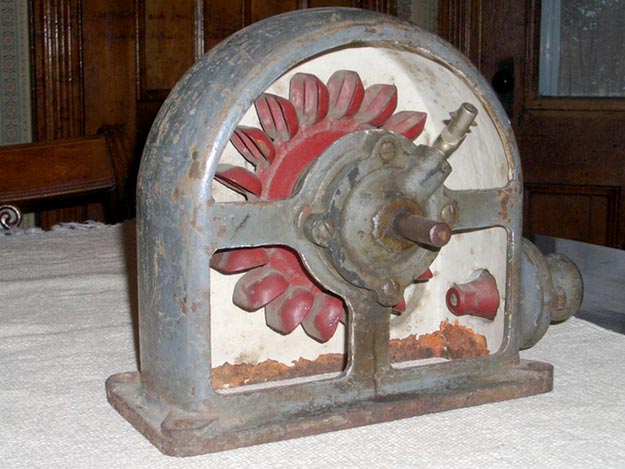The small electric motor was probably revolutionary than the electric light bulb; people could get light from gas or candles, but the motor led to the development of fans and home appliances, and changed the way factories were designed and goods were produced. But before there was universal delivery of electricity, there was tap water, and Kris De Decker of Low-Tech Magazine describes how water-powered motors did many of the same tasks.
In Europe, small motors using the public water supply appeared in the 1840s. In the US, they came into extensive use in the 1870s and 1880s. A water motor consisted of a small water turbine that was suspended in a metal casing. The diameter of the turbine runner could be anywhere between from 20 to 90 cm.
The smallest water motors were used to run sewing machines, jigsaws, fans, and other similarly mechanized items. The somewhat larger water motors were recommended for operating coffee grinders, ice cream freezers, jeweler’s and locksmith’s lathes, grindstones, church organs, or drug and paint mills. The largest water motors were used to run elevators or circular saws. In water powered washing machines, the water that was needed to wash the clothes was capable of providing power to the machine simultaneously.
Like toilets, these are parasitic devices that use water in ways and quantities that the designers of the water systems never expected.
The main drawback of water motors was their very high use of potable water. Using a 1.25 cm diameter pipe and a pressure of 70 psi, a water motor consumed 30 litres of water per minute for a power output of 243 watts. This means that it took 7,440 litres of water to produce 1 kWh of mechanical energy. To give an idea: People today in the west consume less than 500 liters of potable water per day, and they consume at least 5 kWh of electric energy per day.
But then water wasn’t metered then, so people could use as much as they could get away with and just throw it away after.
Source: http://www.treehugger.com/
Dear User/Visitor! Please, answer on our questions: tick off one of the positions – your answer will make us able to improve our site and make it more interesting and useful!


